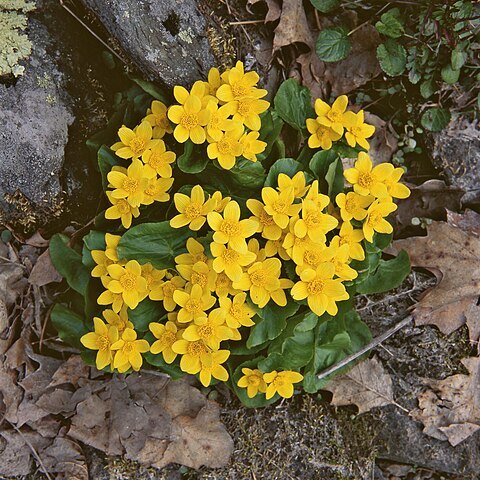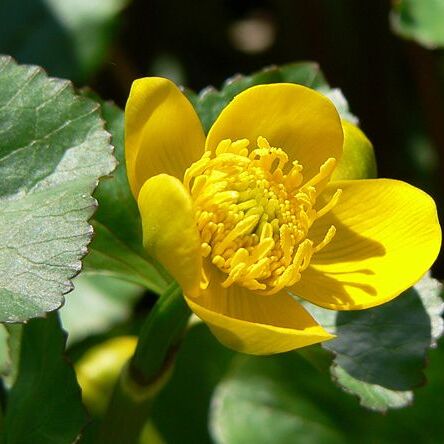Herbs, usually terrestrial perennials, some aquatics and some annuals, woody climbers, or rarely small shrubs. Leaves spiral, in a basal rosette, or opposite (rarely whorled), compound or simple, often palmately lobed or dissected; petioles usually with sheathing base and without stipules. Flowers solitary and terminal or in cymes, racemes or panicles, actinomorphic or zygomorphic, bisexual, rarely unisexual and dioecious (some Clematis spp.), nectar-secreting and insect-pollinated, rarely wind-pollinated. Perianth hypogynous, whorled or spiral, undifferentiated, sepaloid or petaloid or consisting of calyx and corolla, the latter formed usually of petaloid nectaries (honey-leaves, here treated as petals), rarely true petals (Adonis ), usually 5 or more, rarely reduced to 2, 1 or absent. Stamens mostly numerous, rarely 2 or 1, spiral; filaments free; anthers extrorse, opening in longitudinal slits; rarely with connective appendages. Carpels 1–many, free and spiral or in 1 whorl and ± fused; style usually well developed; ovules 1–many, ventral or basal, anatropous; integuments 1 or 2. Fruit of 1–many follicles or a head of achenes, or rarely a berry or capsule; seeds 1–many, usually with a small embryo and oily endosperm; germination usually epigeal.
Herbs perennial or annual, sometimes subshrubs or herbaceous or woody vines. Leaves basal and cauline, alternate, rarely opposite or whorled, simple or variously compound, palmately nerved, rarely penninerved, with or without stipules. Inflorescence a simple or compound monochasium, dichasium, simple or compound raceme, or flowers solitary. Flowers bisexual, sometimes unisexual, actinomorphic, rarely zygomorphic, hypogynous. Sepals 3--6 or more, free, petaloid or sepaloid, imbricate or sometimes valvate in bud. Petals present or absent, 2--8 or more, free, usually with nectaries. Stamens numerous, rarely few, free; filaments linear or filiform; anthers latrorse, introrse, or extrorse; sometimes some sterile stamens becoming staminodes. Carpels numerous or few, rarely 1, free, rarely connate to various degrees; ovary with 1 to many ovules. Fruit follicles or achenes, rarely capsules or berries. Seeds small, with abundant endosperm and minute embryo.
Herbs or woody climbers or subshrubs. Leaves frequently compound with sheathing bases and most often without stipules, spirally arranged or opposite. Inflorescence generally terminal and many flowered, more rarely with few flowers, or these solitary. Flowers regular or irregular. Sepals free, hypogynous, sometimes petaloid. Petals sometimes absent, if present free, hypogynous, some nectariferous. Stamens indefinite in number, hypogynous. Carpels indefinite in number, few, or solitary, free or more or less joined together (if not solitary), with one or several ovules. Fruits achenes, drupelets, follicles, or capsules. Seeds without arils, with endosperm
Annual or perennial herbs with radical and alternate or spiral leaves, or shrublets or woody climbers with opposite or verticillate leaves
Perennial (rarely annual) herbs with alternate leaves, or rarely shrubs or climbers with opposite leaves; stipules absent
Fruit a bunch of follicles, rarely baccate, or of dry achenes with often persistent and elongated styles
Carpels numerous, free or rarely partially connate, with a slightly bifid style or subsessile stigma
Perianth usually double, of calyx and corolla, or rarely the calyx petaloid and the petals absent
Flowers actinomorphic or zygomorphic, hypogynous, bisexual or sometimes polygamous or dioecious
Inflorescences generally terminal and many-flowered or more rarely with few or solitary flowers
Carpels indefinite in number, few or solitary, free or more or less united; ovules 1-several
Seeds small, usually smooth; embryo very small, at the base of horny or fleshy endosperm
Stamens indefinite in number; anthers attached at the base, dehiscing longitudinally
Leaves simple or compound, entire, lobed or dissected, usually with sheathing bases
Fruit usually of achenes, drupelets or follicles, rarely a capsule or berry
Stamens numerous, free from one another; anthers dehiscing longitudinally
Flowers hermaphrodite, hypogynous, usually actinomorphic
Petals when present often with a nectariferous claw
Petals free, sometimes nectariferous, often absent
Sepals free, often petaloid
Sepals imbricate or valvate
Ovules numerous or solitary
Indumentum of simple hairs
Seeds with endosperm


